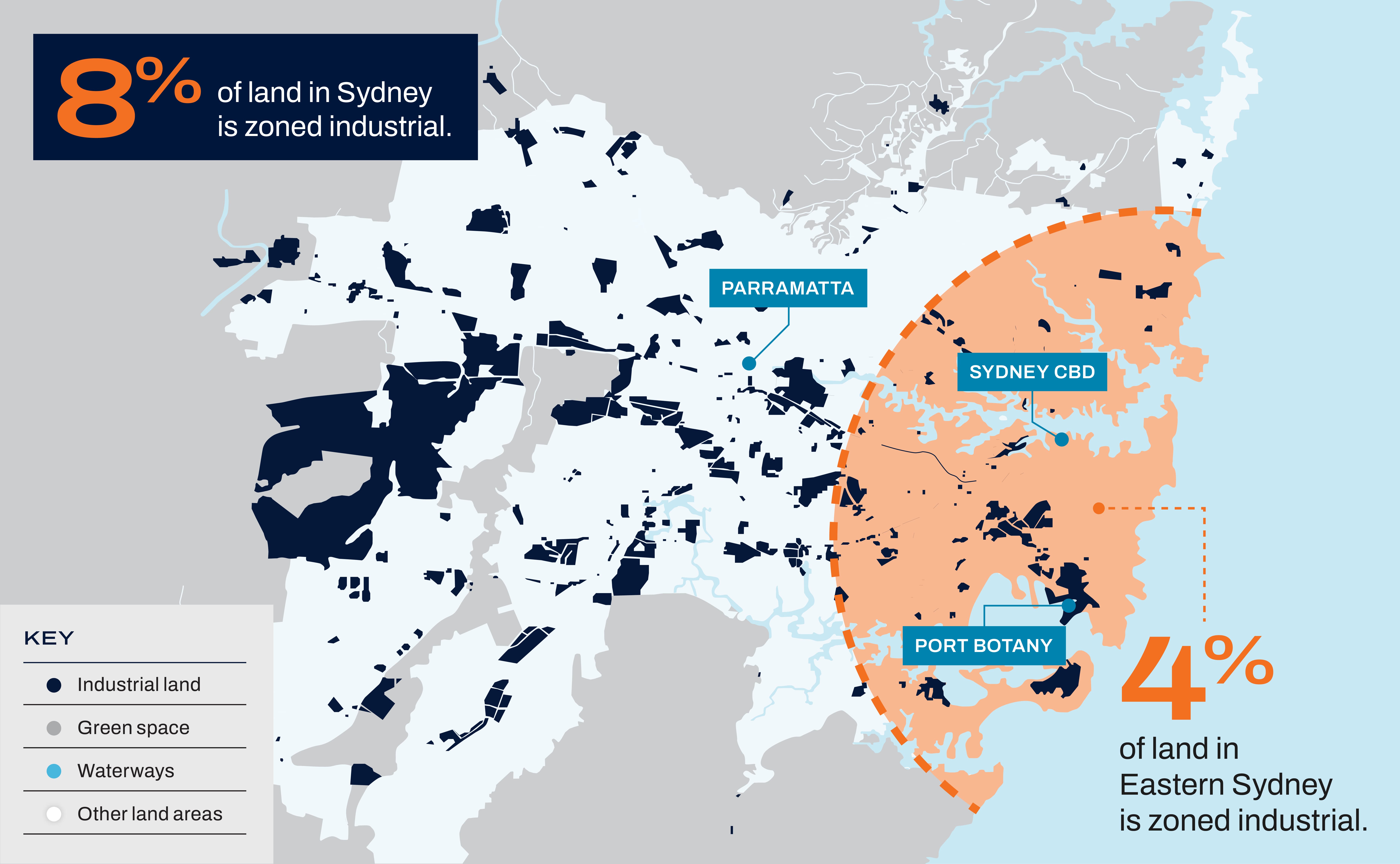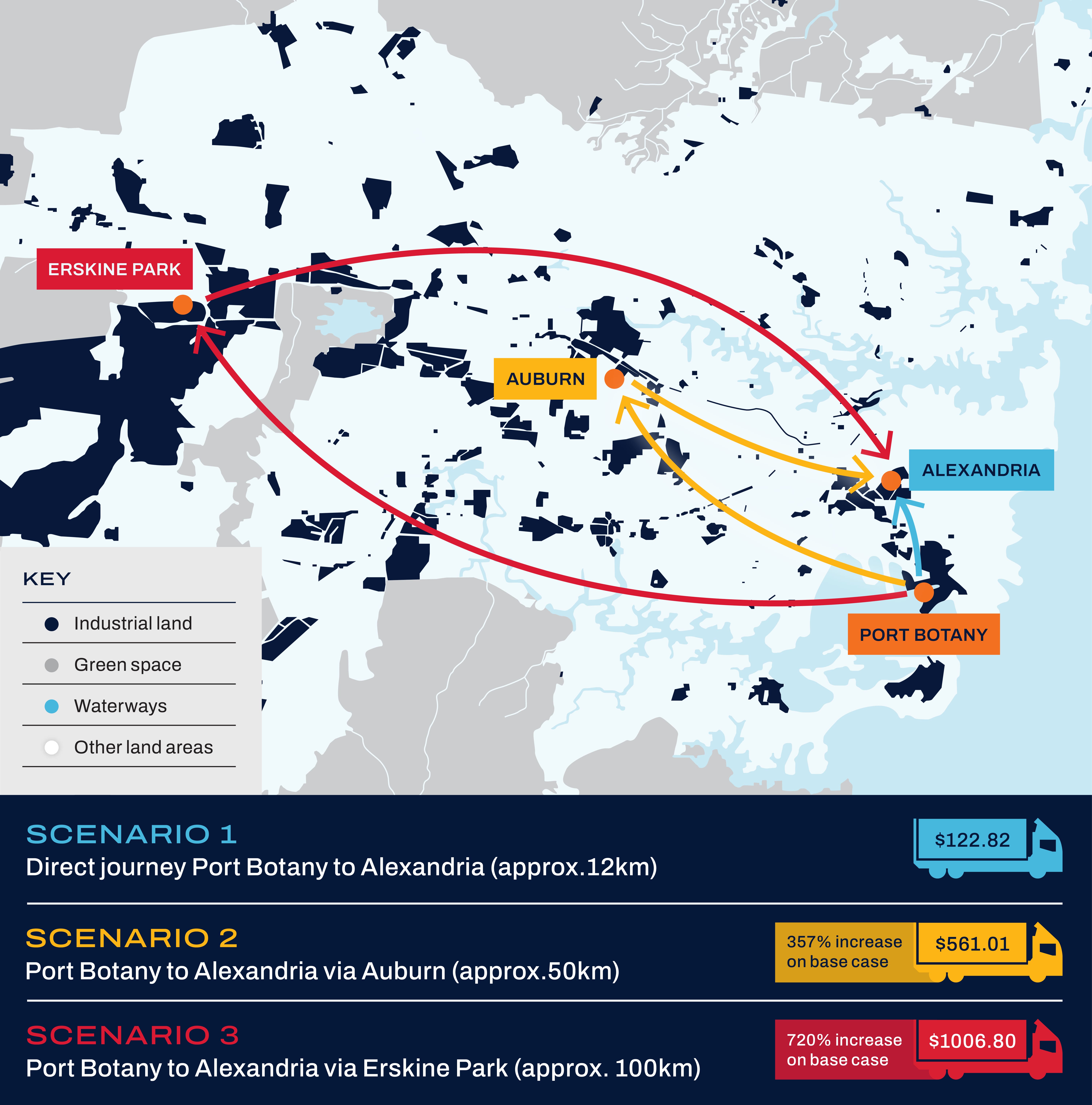Overview
Industrial land is critical to the local, state and national economy.
These sites are used by local job-creating industries, including manufacturing, utilities, mechanics, logistics and other operations to provide goods and services to our cities and the state.
Industrial lands are also required within urban areas for urban services and to support e-commerce, food delivery and ‘last mile’ logistics.
The freight and logistics supply chain requires large parcels of land for warehouses, depots and logistics services, located close to end users to minimise transport distances.
In Sydney, 42% of goods in the average household are imported via a container through Port Botany and need to be unpacked in warehouses and depots located on industrial lands, to be distributed to businesses and customers throughout Sydney.
Lack of industrial lands in Sydney
The availability of industrial lands in Greater Sydney has been in decline for decades, caused by a lack of new supply of zoned and serviced industrial land, as well as historical rezonings for non-industrial uses.
At the same time, container volumes have grown to meet the needs of a growing population and are forecast to potentially triple over the next 40 years.
Despite this, in 2023, Sydney's industrial vacancy rate reached 0.2% - the lowest of any major city in the world at the time.
Industrial lands need to be located close to businesses and customers, to keep transport and distribution costs as low as possible. This means industrial lands are required within Greater Sydney to service the State’s key business district and largest population centre.

The scarcity of industrial land in Sydney is causing significant challenges for businesses and industry, including:
- Higher rents for Sydney businesses compared to other capital cities which have more affordable sites closer to their largest population centres.
- Few suitable sites available for businesses to locate their warehouses and distribution centres or to grow their operations.
- Businesses are locating, expanding or relocating from Sydney to other Australian cities as a result – taking their investment and jobs with them.
- Available sites moving further away from the most populated parts of Sydney, which increases transport costs, delivery times and emissions.
The graphic below shows the difference in transport costs for a container of goods destined for and unpacked in Alexandria, as opposed to a container destined for Alexandria which is unpacked in Auburn or Erskine Park where there are more industrial lands.

How does the lack of industrial land impact Sydney's liveability?
Industrial lands are a key ingredient for liveable, prosperous cities.
Planning policies must recognise the need to protect existing – and unlock new - industrial lands to ensure Greater Sydney remains sustainable for future generations.
Without adequate strategic planning and policy, industry and businesses risk having their operations constrained due to urban encroachment through caps and curfews and insufficient land availability for growth.
In the absence of minimum design standards for residential developments and adequate buffer zones between residential and industrial precincts, restrictions will continue to be imposed on industrial land uses to address community amenity concerns, impacting productivity through the supply chain.
Unless the continued decline of industrial land is addressed, Sydney’s businesses and communities will continue to be impacted by:
- Fewer job opportunities as businesses base their operations in more affordable states and where there is greater industrial land availability.
- Increased cost of goods for consumers as higher transport and operating costs incurred by businesses are subsequently passed on.
- Longer wait times for goods to be delivered.
- Higher emissions as trucks transport goods over longer distances also adding to road congestion.
Recommendations
Action is urgently needed to ensure Greater Sydney remains sustainable for future generations:
- Retain all existing industrial land and expand supply through rezoning and servicing of additional land. Existing industrial land (including in urban areas) should not be rezoned for other uses.
- Prevent the subdivision of large parcels of industrial land into small lots unsuitable for freight, logistics and industrial activities and encourage the consolidation of small industrial lots into larger land parcels.
- Optimise the use of existing industrial lands and avoid constraints from urban encroachment by:
- implementing measures to increase capacity and utilisation
- improving the planning approvals process, including 24/7 operations, improving design standards of residential developments in urban areas; and
- creating buffer zones to minimise impacts on communities.
